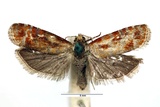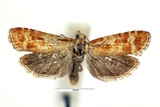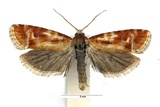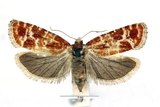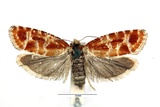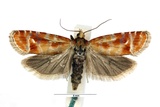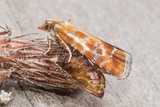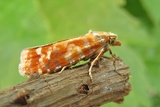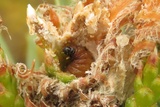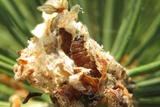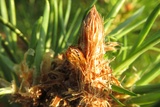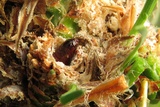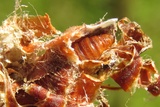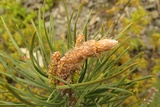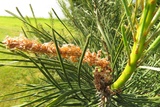Rhyacionia buoliana (Denis & Schiffermüller, 1775) Species
Last modified: Dec. 4, 2024, 2:05 p.m.
A fairly common species in the northern part of Belgium, elsewhere rather rare.
Details
- Classification
- Family: Tortricidae > Subfamily: Olethreutinae > Tribus: Eucosmini > Genus: Rhyacionia > Species: Rhyacionia buoliana
- Vernacular names
- Gewone dennenlotboorder (NL), Pine Shoot Moth, Pine Shoot (EN), Kiefern-Knospentriebwickler (DE)
- Synonyms
- Rhyacionia gemmana (Hübner, 1819)
- First mention in Belgium
- De Sélys-Longchamps E. 1844. Énumération des insectes Lépidoptères de la Belgique. — Mémoires de la Société royale des Sciences de Liége 2: 1–35. On page 21.
- Status
-
Native
Distribution
Imago
Wingspan 16–24 mm. Forewings are reddish-orange with silvery transverse lines. It shows a large and triangular pre-tornal marking, often forming a continuous band across the forewing. Almost never a white pattern in the external area of wing. Hind wings are strikingly dark. Colors more intense, whites more washed out.
Egg
The eggs are yellowish-white when oviposited, changing in colour to greyish-yellow shortly after hatching and finally becoming orange-brown.
Flight periods
The adults fly from late May till the end of August.
Observed on
- Host plant (genera):
- Pinus
The larva lives in a developing bud of Pinus sylvestris, Pinus nigra, Pinus contorta and Pinus sp. Young trees are favoured.
Habitat
It inhabits pine forest, plantations, sandy areas with scattered pines and heathlands.
